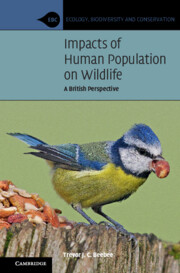Book contents
- Impacts of Human Population on Wildlife
- Ecology, Biodiversity and Conservation
- Impacts of Human Population on Wildlife
- Copyright page
- Dedication
- Contents
- Preface
- Acknowledgements
- Abbreviations
- 1 Population Matters
- 2 The State of British Wildlife
- 3 Human Activities Directly Killing Wildlife
- 4 Impacts of Development on Wildlife Declines
- 5 Impacts of Farming and Forestry on Wildlife Declines
- 6 Climate Change, Disease and Disturbance
- 7 The Human Population and Wildlife in Britain and Western Europe
- 8 Public Perceptions of Wildlife and Population Issues
- 9 International Aspects of Population Growth
- 10 Conservation in a Crowded Country
- References
- Index
5 - Impacts of Farming and Forestry on Wildlife Declines
Published online by Cambridge University Press: 09 June 2022
- Impacts of Human Population on Wildlife
- Ecology, Biodiversity and Conservation
- Impacts of Human Population on Wildlife
- Copyright page
- Dedication
- Contents
- Preface
- Acknowledgements
- Abbreviations
- 1 Population Matters
- 2 The State of British Wildlife
- 3 Human Activities Directly Killing Wildlife
- 4 Impacts of Development on Wildlife Declines
- 5 Impacts of Farming and Forestry on Wildlife Declines
- 6 Climate Change, Disease and Disturbance
- 7 The Human Population and Wildlife in Britain and Western Europe
- 8 Public Perceptions of Wildlife and Population Issues
- 9 International Aspects of Population Growth
- 10 Conservation in a Crowded Country
- References
- Index
Summary
Farming has experienced a major revolution in post-war Britain. The advent of artificial fertilisers and powerful pesticides transformed agriculture, which, combined with financial subsidies, greatly increased food production starting in the 1950s. These changes proved devastating for farmland wildlife. Hedges were removed to increase field sizes, ponds were discarded, autumn ploughing and use of silage devastated wildflower meadows. Many species of plants, invertebrates and birds declined dramatically as a result of these ‘improvements’. Drainage, water abstraction and pollution from fertilisers virtually exterminated many freshwater organisms, including amphibians, over much of the countryside. The marine environment has not been unscathed, with ongoing damage from offshore fish farms and bottom trawling. Dense conifer plantations, initiated after the First World War, have wrecked precious habitats such as heathlands and have precipitated declines of rare species dependent on them. The primary objective of agricultural intensification, a move towards self-sufficiency in food production, has not been met and has actually decreased as the human population has expanded.
- Type
- Chapter
- Information
- Impacts of Human Population on WildlifeA British Perspective, pp. 94 - 124Publisher: Cambridge University PressPrint publication year: 2022



